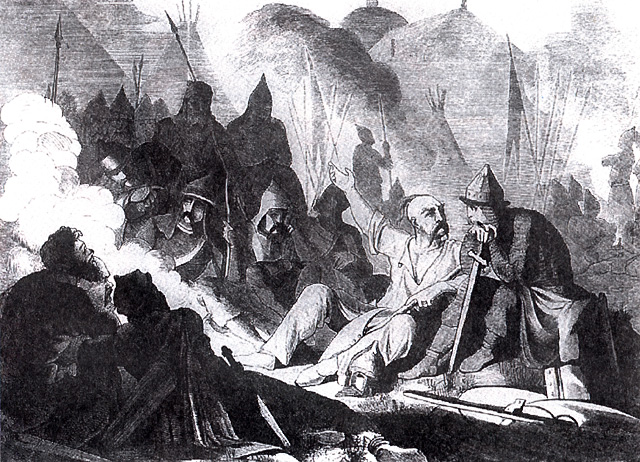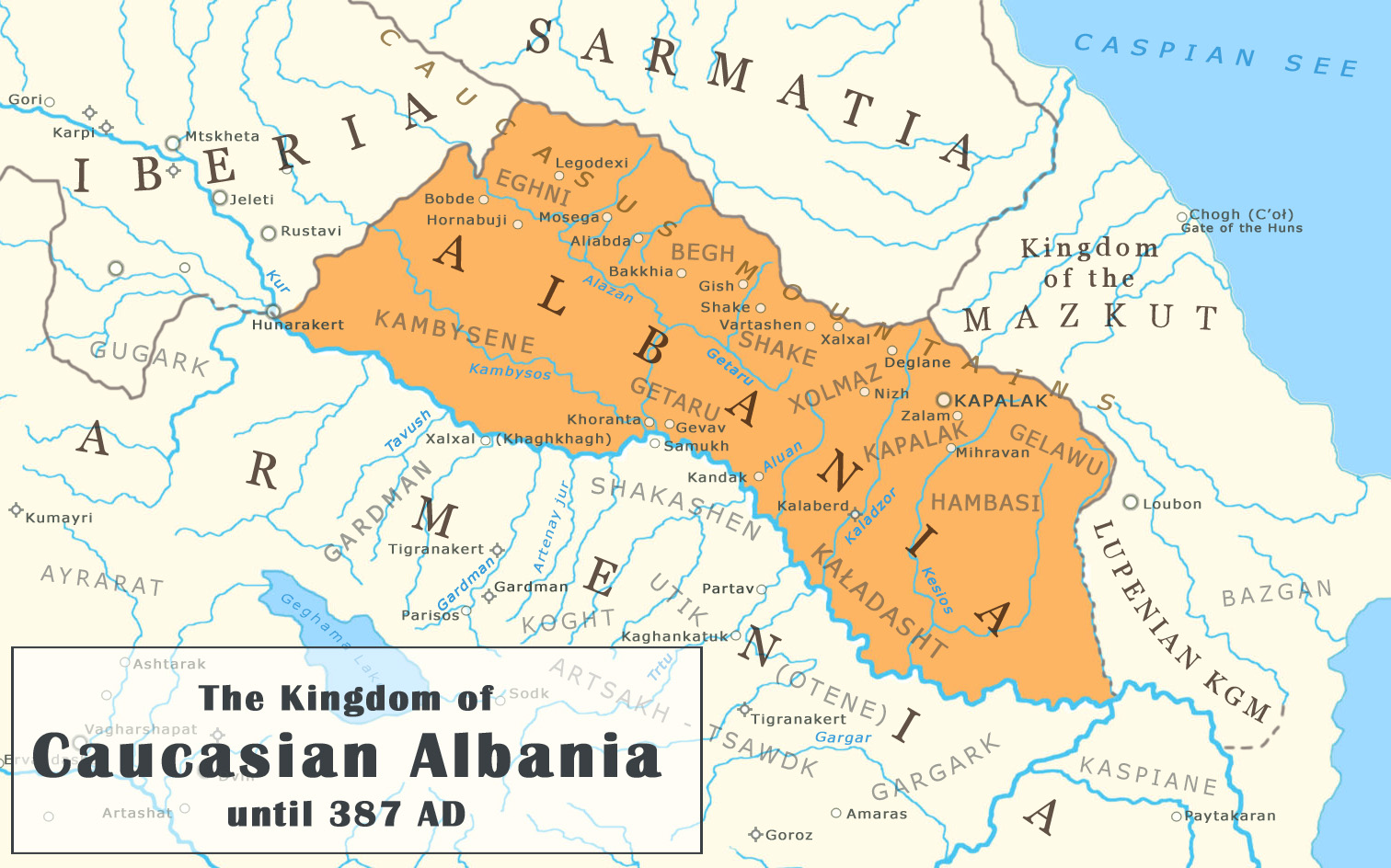|
Caspian Raids Of The Rus'
The Caspian expeditions of the Rus' were military raids undertaken by the Rus' between the late 9th century and 1041 on the Caspian Sea shores, of what are nowadays Iran, Dagestan, and Azerbaijan. Initially, the Rus' appeared in Serkland in the 9th century travelling as merchants along the Volga trade route, selling furs, honey, and slaves. The first small-scale Viking raids took place in the late 9th and early 10th century. The Rus' undertook the first large-scale expedition in 913; having arrived on 500 ships, they pillaged in the Gorgan region, in the territory of present-day Iran, and more to the west, in Gilan and Mazandaran, taking slaves and goods. On their return, the northern raiders were attacked and defeated by the Khazars in the Volga Delta, and those who escaped were killed by the local tribes in the middle Volga. During their next expedition in 943, the Rus' captured Bardha'a, the capital of Arran, in the modern-day Republic of Azerbaijan. The Rus' stayed there fo ... [...More Info...] [...Related Items...] OR: [Wikipedia] [Google] [Baidu] |
Rus' People
The Rus, also known as Russes, were a people in early medieval Eastern Europe. The scholarly consensus holds that they were originally Norsemen, mainly originating from present-day Sweden, who settled and ruled along the river-routes between the Baltic and the Black Seas from around the 8th to 11th centuries AD. The two original centres of the Rus' were Ladoga (''Aldeigja''), founded in the mid-8th century, and Rurikovo Gorodische (''Holmr''), founded in the mid-9th century. The two settlements were situated at opposite ends of the Volkhov River, between Lake Ilmen and Lake Ladoga, and the Norsemen likely called this territory ''Gardar''. From there, the name of the Rus' was transferred to the Middle Dnieper, and the Rus' then moved eastward to where the Finnic tribes lived and southward to where the Slavs lived. The name '' Garðaríki'' was applied to the newly formed state of Kievan Rus', and the ruling Norsemen along with local Finnic tribes gradually assimilated in ... [...More Info...] [...Related Items...] OR: [Wikipedia] [Google] [Baidu] |
Serkland
In Old Norse sources, such as sagas and runestones, Serkland (also ''Særkland'', ''Srklant'', ''Sirklant'', ''Serklat'', etc.) was the "land of the ''Serkir''", usually identified with the Saracens. The exact etymology is disputed. ''Serk''- may derive from "Saracen"; from ''sericum'', Latin for "silk", implying a connection with the Silk Road; from the Khazar fortress of Sarkel; or from ''serkr'', shirt or gown, i.e., "land of the gown-wearers". In all cases it refers to a land in the East. Originally, it referred to the land south of the Caspian Sea, but it gradually expanded to cover all Islamic lands, including parts of Africa (and possibly even Muslim Sicily). Notably one of the Ingvar runestones, the Ingvar runestones#Sö 179, Sö 179, raised circa 1040 at Gripsholm Castle, commemorates a Varangians, Varangian loss during an ill-fated raid in Serkland. The other remaining runestones that talk of Serkland are Ingvar runestones#Sö 131, Sö 131, Ingvar runestones#Sö 279, Sö ... [...More Info...] [...Related Items...] OR: [Wikipedia] [Google] [Baidu] |
Norsemen
The Norsemen (or Northmen) were a cultural group in the Early Middle Ages, originating among speakers of Old Norse in Scandinavia. During the late eighth century, Scandinavians embarked on a Viking expansion, large-scale expansion in all directions, giving rise to the Viking Age. In English-language scholarship since the 19th century, Norse seafaring traders, settlers and warriors have commonly been referred to as Vikings. Historians of Anglo-Saxon England often use the term "Norse" in a different sense, distinguishing between Norse Vikings (Norsemen) from Norway, who mainly invaded and occupied the islands north and north-west of Britain as well as Ireland and western Britain, and Danish Vikings, who principally invaded and occupied eastern Britain. History of the terms ''Norseman'' and ''Northman'' The word ''Norseman'' first appears in English during the early 19th century: the earliest attestation given in the third edition of the ''Oxford English Dictionary'' is from ... [...More Info...] [...Related Items...] OR: [Wikipedia] [Google] [Baidu] |
Ingvar The Far-Travelled
Ingvar the Far-Travelled (Old Norse: ''Yngvarr víðfǫrli'', Swedish: ''Ingvar Vittfarne'') was a Swedish Viking who led an expedition that fought in the Kingdom of Georgia. The Rus' undertook several Caspian expeditions in the course of the 10th century. The '' Yngvars saga víðförla'' describes the last Viking campaign in the Caspian in 1041, embellishing the historical facts with a great deal of legend. The expedition probably aimed to reopen old trade-routes after the Volga Bulgars and the Khazars no longer proved obstacles. Ingvar the Far-Travelled launched this expedition from Sweden, travelling down the Volga River into the land of the Saracens ( Serkland). While there, the Vikings apparently took part in the 1042 Battle of Sasireti between the Georgians and Byzantines. No less than twenty-six Ingvar runestones – twenty-four of them in the Lake Mälaren region of Uppland in Sweden – refer to Swedish warriors who went out with Ingvar on his expedition to ... [...More Info...] [...Related Items...] OR: [Wikipedia] [Google] [Baidu] |
Kyiv
Kyiv, also Kiev, is the capital and most populous List of cities in Ukraine, city of Ukraine. Located in the north-central part of the country, it straddles both sides of the Dnieper, Dnieper River. As of 1 January 2022, its population was 2,952,301, making Kyiv the List of European cities by population within city limits, seventh-most populous city in Europe. Kyiv is an important industrial, scientific, educational, and cultural center. It is home to many High tech, high-tech industries, higher education institutions, and historical landmarks. The city has an extensive system of Transport in Kyiv, public transport and infrastructure, including the Kyiv Metro. The city's name is said to derive from the name of Kyi, one of its four legendary founders. During History of Kyiv, its history, Kyiv, one of the oldest cities in Eastern Europe, passed through several stages of prominence and obscurity. The city probably existed as a commercial center as early as the 5th century. A Slav ... [...More Info...] [...Related Items...] OR: [Wikipedia] [Google] [Baidu] |
Sviatoslav I Of Kiev
Sviatoslav or Svyatoslav I Igorevich (; Old Norse: ''Sveinald''; – 972) was Prince of Kiev from 945 until his death in 972. He is known for his persistent campaigns in the east and south, which precipitated the collapse of two great powers in Eastern Europe, Khazaria and the First Bulgarian Empire. He conquered numerous East Slavic tribes, defeated the Alans and attacked the Volga Bulgars, and at times was allied with the Pechenegs and Magyars (Hungarians). Following the death of his father Igor in 945, Sviatoslav's mother Olga reigned as regent in Kiev until 962. His decade-long reign over the Kievan Rus' was marked by rapid expansion into the Volga River valley, the Pontic steppe, and the Balkans, leading him to carve out for himself the largest state in Europe. In 969, he moved his seat to Pereyaslavets on the Danube. In 970, he appointed his sons Yaropolk and Oleg as subordinate princes of Kiev and Drelinia, while he appointed Vladimir, his son by his housekeeper ... [...More Info...] [...Related Items...] OR: [Wikipedia] [Google] [Baidu] |
Dysentery
Dysentery ( , ), historically known as the bloody flux, is a type of gastroenteritis that results in bloody diarrhea. Other symptoms may include fever, abdominal pain, and a feeling of incomplete defecation. Complications may include dehydration. The cause of dysentery is usually the bacteria from genus '' Shigella'', in which case it is known as shigellosis, or the amoeba '' Entamoeba histolytica''; then it is called amoebiasis. Other causes may include certain chemicals, other bacteria, other protozoa, or parasitic worms. It may spread between people. Risk factors include contamination of food and water with feces due to poor sanitation. The underlying mechanism involves inflammation of the intestine, especially of the colon. Efforts to prevent dysentery include hand washing and food safety measures while traveling in countries of high risk. While the condition generally resolves on its own within a week, drinking sufficient fluids such as oral rehydration solutio ... [...More Info...] [...Related Items...] OR: [Wikipedia] [Google] [Baidu] |
Arran (Azerbaijan)
Caucasian Albania is a modern exonym for a former state located in ancient times in the Caucasus, mostly in what is now Azerbaijan (where both of its capitals were located). The modern endonyms for the area are ''Aghwank'' and ''Aluank'', among the Udi people, who regard themselves as descended from the inhabitants of Caucasian Albania. However, its original endonym is unknown. The name Albania is derived from the Ancient Greek name and Latin , created from Greek sources that incorrectly translated the Armenian language. The prefix "Caucasian" is used to avoid confusion with Albania in the Balkans, which has no geographical or historical connections to Caucasian Albania. Little is known of the region's prehistory, including the origins of Caucasian Albania as a geographical and/or ethnolinguistic concept. In the 1st century BC and the 1st century AD, the area south of the Greater Caucasus and north of the Lesser Caucasus was divided between Caucasian Albania in the east, Cauca ... [...More Info...] [...Related Items...] OR: [Wikipedia] [Google] [Baidu] |
Barda, Azerbaijan
Barda ( ) is a city and the capital of the Barda District in Azerbaijan, located south of Yevlax and on the left bank of the Tartar river. It served as the capital of Caucasian Albania by the end of the 5th century. Barda became the chief city of the Islamic province of Arran, the classical Caucasian Albania, remaining so until the 10th century. Etymology The name of the town derives from () which derives from Old Armenian ''Partaw'' ( Պարտաւ). The etymology of the name is uncertain. According to the Iranologist Anahit Perikhanian, the name is derived from Iranian *''pari-tāva-'' 'rampart', from *''pari-'' 'around' and *tā̆v- 'to throw; to heap up'. According to the Russian-Dagestani historian Murtazali Gadjiev, however, the name means "Parthian/Arsacian" (cf. Parthian ''*Parθaυ''; Middle Persian: ''Pahlav''; Old Persian: ''Parθaυa-''). The name is attested in Georgian as ''Bardav ' (ბარდავი). History Ancient According to '' The History of the Co ... [...More Info...] [...Related Items...] OR: [Wikipedia] [Google] [Baidu] |
Volga
The Volga (, ) is the longest river in Europe and the longest endorheic basin river in the world. Situated in Russia, it flows through Central Russia to Southern Russia and into the Caspian Sea. The Volga has a length of , and a catchment area of .«Река Волга» , Russian State Water Registry It is also Europe's largest river in terms of average discharge at delta – between and – and of . It is widely regarded as the national river of |
Volga Delta
The Volga Delta is the largest river delta in Europe and occurs where Europe's largest river system, the Volga River, drains into the Caspian Sea in Russia's Astrakhan Oblast, north-east of the republic of Kalmykia. The delta is located in the Caspian Depression—the far eastern part of the delta lies in Kazakhstan. The delta drains into the Caspian approximately downstream from the city of Astrakhan. The Volga delta has grown significantly in the 20th century because of changes in the level of the Caspian Sea. In 1880, the delta had an area of . Today the Volga Delta covers an area of and is approximately across. It has a classical "delta pattern". The delta lies in the arid climate zone, characterized by very little rainfall. The region receives less than one inch of rainfall in January and July in normal years. Strong winds often sweep across the delta and form linear dunes. Along the front of the delta, one will find muddy sand shoals, mudflats, and coquina banks. ... [...More Info...] [...Related Items...] OR: [Wikipedia] [Google] [Baidu] |
Mazandaran Province
Mazandaran Province (; ) is one of the 31 provinces of Iran. Its capital is the city of Sari. Located along the southern coast of the Caspian Sea and in the adjacent Central Alborz mountain range and Hyrcanian forests, it is bordered clockwise by Russia (across the sea), Golestan, Semnan, Tehran, Alborz, Qazvin, and Gilan Provinces. Mazandaran, founded in 1937, covers an area of 23,842 km2. The province has diverse natural resources, notably large offshore reservoirs of oil and natural gas. The diverse natural habitats of the province include plains, prairies, forests and rainforest stretching from the sandy beaches of the Caspian Sea to the rugged and snowcapped Alborz sierra, including Mount Damavand, one of the highest peaks and volcanoes in Asia. Mazandaran is a major producer of farmed fish,Freshw ... [...More Info...] [...Related Items...] OR: [Wikipedia] [Google] [Baidu] |






